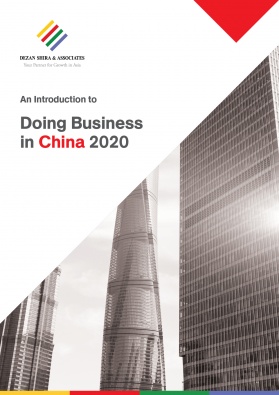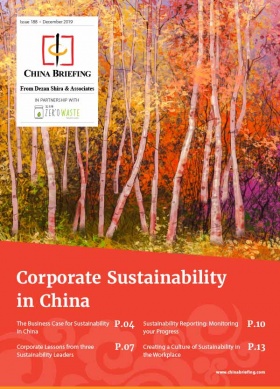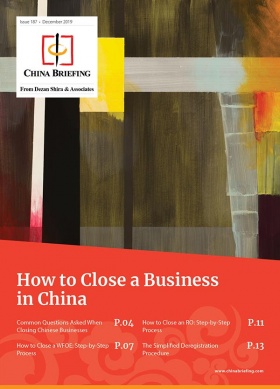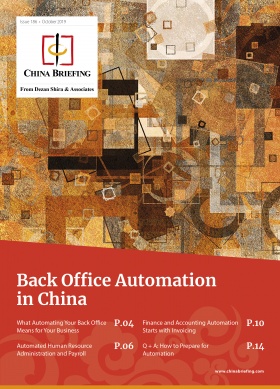What to Expect as China’s Economy Enters 2020?
After an eventful year, China is heading into 2020 in a cloud of uncertainty.
Although the US and China recently agreed to a “phase one” trade deal, bilateral trade tensions are far from being ironed out. Similarly, protests in Hong Kong have calmed but the underlying socioeconomic issues have yet to be resolved.
Meanwhile, the Chinese government is powering ahead with its campaign to contain financial risks, putting into question the country’s ability to maintain its decades-long streak of rapid economic growth.
Despite the current challenges, more predictable, long-term trends point to enduring opportunities for foreign investors in China.
China’s urban middle class continues to grow bigger and more sophisticated in their consumption habits, which translates to flourishing opportunities in lifestyle, education, and healthcare sectors.
As first and second tier cities become saturated, China’s emergent consumer class is expanding quickly in the country’s numerous “lower tier” cities.
Yet, while China’s enormous market offers lucrative opportunities to its investors, these are becoming more complicated by way of new socioeconomic and geopolitical challenges – further exacerbated by the ongoing slowdown and US-China trade war. Some of these are, however, a natural consequence of China’s status as a maturing economy with expanding ambitions on the global stage.
With these trends in mind, we look at what foreign investors can expect from China in 2020.
Persisting trade and tech tensions
US-China relations seemingly closed the year on a positive note with the signing of the “phase one” trade deal although bilateral tensions are set to persist. It is a positive sign that an initial agreement was formed, but the outcome was a result of diminished expectations borne out of routinely deadlocked trade negotiations.
Whereas the two sides appeared to be close to a comprehensive trade deal at various points, breakdowns in negotiations eventually led them to settle for a lesser deal – and short on substantive progress.
Thus, the US and China may not be any closer to ending the tariffs completely than they were several months ago. And as trade negotiations continue into 2020, the upcoming US presidential elections will add an extra element of uncertainty into the mix.
Nevertheless, while US-China tariffs added costs for global businesses in a number of sectors and increased uncertainty among investors, it did not substantially impact China’s economy in the short term.
On the other hand, a technology decoupling between China and Western countries will transform China’s investment environment more visibly; this appears on track to occur whether or not a trade deal is signed.
Tech tensions between China and foreign countries began in earnest with the adoption of the Made in China 2025 policy in 2015, which laid out a blueprint for China to become self-sufficient in high-tech industries.
Events that have transpired since have pushed Chinese leaders to redouble on their efforts to reduce external reliance on foreign countries and technology imports. For example, the Chinese government recently ordered all government offices and public institutions to rid themselves of foreign computers and software within three years.
The role of Chinese technology overseas is also poised to become more contentious.
After the Chinese telecommunications company ZTE became controversial in 2018, the political outcry in 2019 in several Western countries from Canada and Australia to Finland and the Czech Republic on the role of Chinese telecommunications giant Huawei in building their 5G networks brought to focus simmering tensions in the global race for high tech.
The Huawei debate will continue in 2020, and other Chinese tech companies may also face the spotlight.The past year alone has offered a taste of what is to come– with the Chinese corporate ownership of widely used social media platforms like Grindr and Tiktok coming under regulatory scrutiny in the US.
In the reverse case, the role of US investors in Chinese tech companies like Hikvision also attracted controversy. Other Chinese tech companies with a substantial overseas presence, like Tencent, can expect to be scrutinized more closely in the coming year.
Moderating growth ahead
After meeting the lower end of the government’s GDP growth target of 6-6.5 percent for 2019, economic planners will likely set a lower target of “around six percent” for 2020, continuing China’s trend of slowing economic growth.
Because of the Chinese government’s outsized role in the economy and ability to direct credit, GDP growth targets are in many ways a statement of intentions than a goal that must be met.
After years of investment-fueled growth, China’s mounting debt is a major concern for economic planners, who fear its potential to trigger an economic crisis. Allowing growth to moderate to levels closer to five percent would therefore ease China’s debt burdens, though many local governments and financial institutions will still struggle in the process.
While growth may slow down to be closer to five percent in the coming decade, growth at about six percent is just as likely as China’s leaders will attempt to straddle the line between managing debt, meeting political goals, and satisfying vested interests.
China needs to grow by around six percent, or a notch lower, for the Communist Party to meet its much-publicized goal of doubling GDP from 2010 levels by the end of 2020. Because of the political importance of meeting this goal–as the Party celebrates its centenary in 2021 – economic planners will almost assuredly promote growth to at least the minimum levels for the government to claim a success.
Yet this does not mean the government will pump the economy with stimulus at all costs. That China continued to prioritize its debt derisking campaign in 2019 despite the trade war and resulting economic uncertainty shows its importance.
According to Reuters, 12 former executives of financial institutions and regulators have been assigned the top posts of the country’s 31 regions since 2018, compared to only two following the 2012 leadership reshuffle. The prominence of financial experts in important leadership positions shows the importance the Party’s top leadership is putting on debt derisking and managing financial risks more sustainably.
Further, prominent government figures have already begun to adjust expectations surrounding economic growth. For example, Wang Yiming, a deputy director at the State Council’s Development Research Center, recently stated in a People’s Daily article that “6% is not a special watershed”.
While China will ensure a minimum level of growth to hit its centenary goals by the end of 2020, economic planners are laying the groundwork for a “new normal” of moderate growth below six percent in the coming years.
Maturing consumption trends
With China’s growth moderating as it settles into upper middle income status, the consumption habits of the country’s ever-expanding middle class are maturing in kind.
Whereas China’s growth once came from investment and export-driven manufacturing, domestic consumers now account for over 60 percent of economic growth. Despite 2019’s economic uncertainty, consumption in China grew by 10 percent through the first 10 months of the year, putting it on pace to almost match growth from 2018.
First-tier cities like Shanghai, Beijing, Shenzhen, and Guangzhou were the first targets of international brands, followed by second-tier cities like Hangzhou, Suzhou, and Chengdu.
While these cities contribute a large amount of China’s consumption, they are quickly becoming saturated, particularly as living costs rise faster than incomes.
Third and fourth tier cities, however, continue to grow quickly and boast a younger consumer market looking to spend immediately. Morgan Stanley has predicted that the consumption power of China’s smaller cities will triple between 2017 and 2030.
Although residents of smaller cities have access to foreign brands through e-commerce platforms, many have not yet fully penetrated these rapidly growing markets. Though these cities are small compared to China’s biggest metropolises, by global standards they are fairly sizable in their own right, generally boasting populations of one million or more.
Whereas first-tier cities are facing caps on their permanent populations, lower tier cities will benefit from increased mobility as a result of hukou reforms, such as those implemented in 2019. These policies will reinforce lower-tier cities’ status as the battlegrounds for market share in 2020 and beyond.
What these cities all have in common is a consumer base that is increasingly prioritizing products and services in the lifestyle, education, and healthcare sectors.
In the 2010s, products such as cars and smartphones experienced huge growth and massive sales, but these sectors have likely peaked and face a largely saturated market. Auto sales, for instance, contracted for the 17th consecutive month in November, putting the market on pace to contract for the second year in a row after a sustained period of expansion.
In contrast, spending on personal wellness is projected to grow unabated. According to a recent survey of Chinese consumers conducted by McKinsey, 72 percent of respondents said they were actively trying to adopt a more active lifestyle.
Spending on healthy foods and activities, education, and travel is growing across the country. While these trends are more mature in first tier cities, lower tier ones are quickly closing the gap.
Similarly, China’s elder care market is expected to grow from RMB 4 trillion (US$5.73 billion) in 2019 to RMB 13 trillion (US$1.86 trillion) by 2030, according to the market research agency PR Newswire, as demographic trends will make China a rapidly greying country. Again, opportunities hit first tier cities first – where the market is older and wealthier – but will soon be joined by lower tier cities.
While these consumption trends are here to stay as Chinese consumers prioritize living standards now that meeting basic needs is less of a concern, foreign companies will face heightened competition from domestic competitors. Foreign brands were once popular merely by virtue of being foreign, but Chinese consumers are increasingly supportive of domestic brands as their quality steadily improve.
As the calendar flips to 2020, foreign investors will continue to find plenty of opportunities in the Chinese market – but also increased competition.
Reforms on the horizon?
China’s 2020 looks to be defined by political challenges, international tension, and macro-economic uncertainty, but also by continued consumer empowerment.
The international conflicts that came to a head over the past two years will not go away any time soon, and may become a new normal that foreign investors will need to carefully navigate.
What is less predictable is what China’s leaders will have in store in terms of particular economic reforms. The opacity of China’s political system means that reforms often seemingly come out of nowhere with little to no advance notice, such as 2019’s Foreign Investment Law and 2018’s overhaul of government institutions.
Although it is unclear what specific reforms may come in 2020, they will likely continue the trend of gradual but not transformative tinkering. Potential reforms on the table include the further simplification of VAT rates and the elimination of family planning restrictions, while more ambitious reforms like the introduction of a property tax appear less likely due to their complexity and sensitivity.
Nevertheless, if 2019 is any indication, 2020 could be another year of surprises in China. In a climate of heightened political risks, foreign investors in China should stay nimble and prepared for the unexpected.
China Briefing is written and produced by Dezan Shira & Associates. The practice assists foreign investors into China and has done since 1992 through offices in Beijing, Tianjin, Dalian, Qingdao, Shanghai, Hangzhou, Ningbo, Suzhou, Guangzhou, Dongguan, Zhongshan, Shenzhen, and Hong Kong. Please contact the firm for assistance in China at china@dezshira.com.
We also maintain offices assisting foreign investors in Vietnam, Indonesia, Singapore, The Philippines, Malaysia, and Thailand in addition to our practices in India and Russia and our trade research facilities along the Belt & Road Initiative.
- Previous Article China’s Global Trade Outlook in 2020: The Risks and Rewards
- Next Article China’s Market Regulator Clarifies Recall Obligations for Consumer Products












